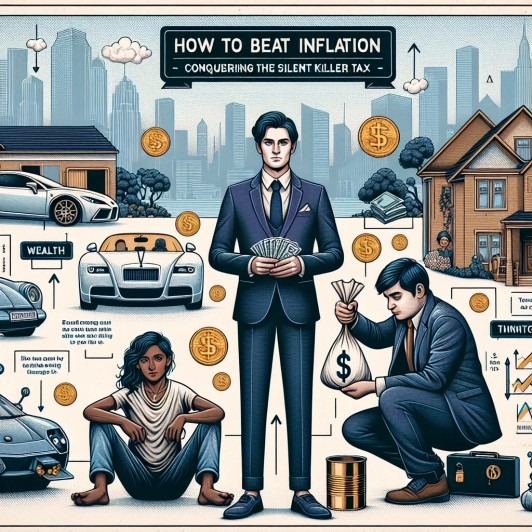
Feb 15, 2024
Understanding Inflation and Lagging Indicators: A Deep Dive
Inflation and lagging indicators – these terms might seem daunting at first, but they are foundation stones in the tower of economics. They have a symbiotic relationship, one informing and influencing the other, creating ripple effects that permeate every corner of our economy.
Undeniably, inflation is a spectre that oscillates between fear and anticipation in economic discourse. It is a complex topic, a moving target in a constantly shifting landscape. But its understanding is pivotal for anyone keen to grasp the economic trends that shape our world.
Inflation, in its most basic form, is the rate at which prices for goods and services rise. It’s why your grocery bill today may be higher than a year ago or the cost of a house has multiplied over the decades. However, it’s not inherently harmful. In manageable doses, inflation is a sign of a healthy, growing economy. It suggests that consumers are spending, businesses are investing, and the economic cogs are turning.
On the other hand, a lagging indicator is an economic factor that changes only after the economy has started to follow a particular pattern or trend. These rearview mirrors of the financial vehicle clearly show where we’ve been. They include metrics like unemployment rates, corporate profits, and, indeed, inflation.
The question “Is inflation a lagging indicator?” becomes less complex when we understand these terms. Inflation reflects changes in the economy’s supply and demand, changes that have already occurred. It is the echo of economic activity, not the shout that precedes it.
Inflation as a Lagging Indicator: Unraveling the Complexity
The relationship between inflation and economic activity forms the crux of many economic discussions. The basic premise is clear-cut: inflation, in its essence, is indeed a lagging indicator. But to fully understand this concept, we must dive deeper into the economic ocean.
Firstly, we must acknowledge that economic activity is the beating heart of any economy. As the heart pumps faster, economies flourish, and the pulse of demand for goods and services quickens. The market becomes a bustling bazaar, with consumers and businesses eagerly exchanging money for goods and services.
However, this rapid heartbeat can outpace the economy’s ability to supply these goods and services. Imagine a famous baker with a finite amount of bread; as the queue outside his shop grows, the price of his loaves inevitably rises. This is the birthplace of inflation – a situation where demand surpasses supply, increasing prices.
But here’s the crux: these effects of inflation, these price hikes, only become apparent after the economic activity that caused them. It’s like a shadow following its caster – the economic activity takes the lead, and inflation trails behind, a faithful follower reflecting the actions of its leader. This lagging nature of inflation is a fundamental concept in understanding its behaviour and role in our economy.
Understanding inflation as a lagging indicator allows us to view it not just as a consequence but as a mirror reflecting the health and activity of an economy. It’s a tale told in hindsight, a story of economic activity narrated through the lens of price changes. It’s a complex tale but essential for anyone eager to understand the economic forces that shape our world.
Historical Evidence: Inflation and GDP Growth – A Retrospective Analysis
Historical data is a powerful tool for understanding economic phenomena. It offers a rearview mirror into the intricate dance between inflation and GDP growth. The U.S. Bureau of Labor Statistics, a treasure trove of such data, clearly illustrates this relationship.
Let’s travel back to 2008, which stands out in economic history. The inflation rate was 3.8%, which might seem high initially. However, juxtaposing this with the GDP growth rate of -0.1%, a fascinating picture emerges. This inflation was not a response to the economic activity of 2008 but rather a delayed reaction to the previous year when GDP growth was a robust 2.8%.
This is a classic example of inflation as a lagging indicator. The inflation rate in 2008 was not a reflection of that year’s economic downturn but rather the echo of the economic growth 2007. It’s akin to the sound of a bell that continues to resonate even after it has been struck, a lingering reminder of a past event.
This historical example underscores the importance of understanding the temporal relationship between inflation and economic activity. It’s easy to associate current inflation rates with current economic conditions. However, as the 2008 example illustrates, inflation reflects past economic activity, not a present snapshot.
Understanding this relationship is not just an academic exercise. It has practical implications for policy, investment strategies, and personal finance decisions. By looking at inflation as a lagging indicator, we can better interpret its movements, anticipate future trends, and make informed decisions.
So, the next time you come across an inflation statistic, remember the story of 2008. Remember that inflation is a mirror reflecting the past, a lagging indicator that tells a tale of economic activity that has already occurred. It’s a lesson from history, a guidepost for the future, and a key to understanding our financial world.
Exception to the Rule: The Pandemic Scenario – An Economic Anomaly
Economics, like life, is full of exceptions to the rule. A perfect example is the 2020 COVID-19 pandemic, which upended economies and rewrote many economic norms. During this time, inflation proved to be a surprising chameleon, transforming from a typical lagging indicator to a coincident or even leading indicator.
The pandemic brought about an abrupt drop in demand. As cities locked down and businesses shuttered, consumption plummeted. People were buying less, not because prices were too high, but because their lifestyles had changed. From frequent dining out and travel to entertainment and non-essential shopping, consumption patterns have drastically turned.
This swift drop in demand resulted in a decrease in inflation, even before the total economic impact of the pandemic was recognized. This deviation is from the norm, where inflation typically lags behind economic activity. Instead, in the case of the pandemic, inflation acted as a canary in the coal mine, hinting at the economic disruption even before the full extent of the crisis unfolded.
This scenario is a potent reminder that while economic principles and trends provide a roadmap, they are not deterministic. The rules can change, especially during significant disruptions like a global pandemic. It also highlights the importance of adaptability and flexibility in interpreting economic indicators.
The pandemic scenario underscores the dynamism and complexity of economics. It’s a field that never stops evolving, where every crisis, every anomaly, and every exception adds a new layer of understanding. It’s a stark reminder that in economics, as in life, we must be ready to expect the unexpected, to adapt our knowledge in the face of new realities, and to learn from the world around us continually.
The Contrarian Perspective: Inflation as a Leading or Coincident Indicator – A Counterpoint
The contrarian perspective often sparks the most thought-provoking discussions within economics. Regarding the inflation debate, this perspective is crucial in broadening our understanding. While the generally accepted belief is that inflation is a lagging indicator, exceptions like the recent pandemic have demonstrated that it can also be a leading or coincident indicator, depending on the circumstances.
The contrarian perspective challenges the standard narrative, arguing that inflation can move in tandem with the economy or even predict future economic trends under unique conditions. This idea may seem unconventional, but it’s one substantiated by the economic anomalies we’ve witnessed recently.
Consider a sudden surge in demand for a product or service spurred by a disruptive innovation or drastic policy change. In such cases, inflation could rise with the demand, acting as a coincident indicator. Similarly, a looming economic crisis, such as the one foreseen during the early stages of the pandemic, can cause inflation to drop, making it a leading indicator of the impending economic downturn.
While the contrarian perspective might veer from the traditional path, it’s a valuable viewpoint that adds depth to our understanding of inflation. It reminds us that economics, like the world it seeks to describe, is not static but dynamic. It encourages us to question, remain open to new insights, and appreciate the nuances that make economics such a fascinating field.
.
The Takeaway: Understanding Inflation’s Role – An Evolving Narrative
The world of economics is much like a grand symphony, with each element crucial in the overall performance. Among these, inflation holds a significant role, often seen as a lagging indicator providing us with economic activity’s aftermath. However, like any good symphony, the magic lies in the fluidity and adaptability of its components.
While inflation typically follows the rhythm of past economic activity, it can change its tune based on the overall economic landscape. The traditional understanding of inflation as a lagging indicator is akin to a familiar melody in this symphony—a tune we know and understand. But, like any good music, it’s not confined to a single note or rhythm.
For instance, the recent pandemic prompted a shift in inflation’s role, transforming it into a coincident or even leading indicator. It was like a sudden change in tempo, a deviation from the familiar, creating a new and unexpected harmony.
This fluidity of economic indicators, including inflation, underscores the dynamic nature of economics. It’s a field that demands a nuanced and adaptable approach that appreciates the complexities and embraces the changes. Relying on conventional wisdom is not enough; we must also be open to new patterns, rhythms, and understandings.
The takeaway here is that understanding inflation’s role isn’t about memorizing definitions or rules. It’s about recognizing its potential to change with the economic landscape and adapting its rhythm in response to the ebbs and flows of economic activity. It’s about appreciating the symphony of economics in all its complexity and dynamism, with inflation as one of its key players, capable of following and leading the melody. It’s an understanding as fluid and adaptable as the economic landscape it seeks to interpret.
The Impact: Informed Decisions and Better Outcomes – The Ripple Effect
Understanding inflation dynamics acts as a compass in the ever-changing landscape of economics. It’s more than just a theoretical concept; it has real-world implications that touch every facet of our lives. As consumers, investors, and citizens, this knowledge equips us with a powerful tool to guide our financial decisions and shape our socio-economic outcomes.
Imagine you’re contemplating buying a house and understanding that inflation is typically a lagging indicator and how it can fluctuate under certain circumstances can help you decipher the right timing for your purchase. It can provide insights into future price trends, enabling you to secure a deal that aligns with your financial goals.
As an investor, this knowledge is like a secret weapon. It can guide your investment strategies, helping you allocate your funds in a way that optimizes your returns while mitigating risks. You can assess the potential impact of inflation on different asset classes, enabling you to craft a diversified portfolio resilient to inflationary pressures.
Understanding inflation’s role can inform your political choices as a citizen. It can shed light on the potential implications of fiscal and monetary policies, helping you cast an informed vote in an election. It allows you to understand the economic narrative behind campaign promises, enabling you to make a choice aligned with your economic perspectives and aspirations.
Conclusion: Embracing the Complexity and Dynamism – A Journey of Understanding
Concluding this exploration into the realm of inflation, it becomes clear that this economic indicator is far from static. It predominantly acts as a rearview mirror, reflecting the economy’s past performance. Yet, extraordinary circumstances can compel it to change roles, transforming it into a compass that aligns with the present or even points towards future trends.
This transformation emphasizes the importance of appreciating the complexity and dynamism inherent in economic indicators. They’re not just fixed markers on a financial map but movable signposts that can alter direction based on the economic winds.
As we hear them on the news or read about them in reports, inflation rates are more than mere statistics or abstract concepts. They’re narratives of our economic journey, offering insights into where we’ve been and, at times, hinting at where we might be heading. They’re the economy’s pulse, beating the rhythm of supply and demand, policy decisions, and external shocks.
So, remember this exploration the next time you encounter a conversation about inflation rates. Consider them not just as numbers on a page but as a vibrant narrative of our economic past, present, and sometimes future. Embrace their complexity, dynamism, and capacity to surprise. Use them as a tool to navigate the economic landscape, make informed decisions, and better understand the world around us.
In economics, each thread – including inflation – has a role. Their interplay, their shifts, and their surprises are what make the field so engaging and so meaningful. Let’s embrace this complexity and dynamism and continue this journey of understanding, one economic indicator at a time.
Journey of Discovery: Fascinating Reads
The Moment of Truth: Predicting the Fed’s Pivot in Monetary Policy










